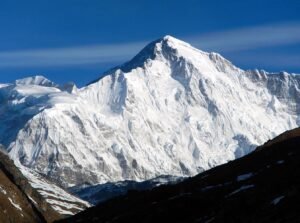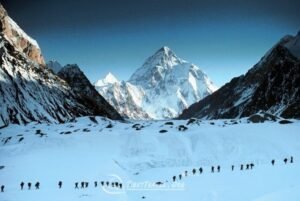If you are interested in climbing the fifth tallest mountain: Makalu
Mount Makalu— Photo via Flickr Rising up to 8,485 meters (27,838 feet), Makalu is the fifth highest mountain on earth and a summit that demands awe and respect. Located in the Mahalangur Himalayas just 19 km southeast of Mount Everest, this solitary behemoth provides a more isolated and technically challenging objective for climbers wanting to test their abilities.
Unlike Everest, which is teeming with commercial expeditions, Makalu remains relatively pristine and wild. The forceful ascents over its blunt edges, knife-edged ridges and steep faces make it a desired dare yet dangerous ascent for mountaineers. In this blog, we will try to cover all the aspects of Mount Makalu including its geographics, history of ascents and climbing routes, all along with some information on how one should prepare themselves to summit this beast.
After over two-decades in the mountaineering world, I know that Makalu is not journey of muscles — it’s an endurance test; not tenacityalogs or a summit checklists — and above all, it requires to pay due homage to the mountain. Whether you’re getting ready for Makalu or just thinking about it, this guide will tell you everything you need to know to stand on the top of one of the world’s highest and most challenging peaks.
Geography of Makalu
Makalu is situated in the northeastern corner of Nepal inside the Makalu Barun Valley. The Makalu massif lies just southeast of the Everest area and is part of the larger Sagarmatha National Park — a World Heritage site in Nepal. Makalu’s remote location and rugged terrain gives it a sense of isolation despite its relative proximity to Everest, and as such it is less frequented by climbers and trekkers.
The pinnacle is well-known for its exclusive shape and coveted 4-sided pyramid look that makes it recognizable to all. While many of the snow-covered peaks of the Himalayas are relatively smooth high-altitude mountains, Makalu is a tougher proposition with its jagged ridges and steep rock faces being far more technical propositions. All these natural defenses have helped maintain Makalu’s reputation as one of the most challenging of 8,000ers.
The Barun Valley, which lies at the base of Makalu, has become internationally well known and ignored place in east Nepal with its vast rain forests, alpine meadows and exceptional presevation of natural trek. The Makalu-Barun National Park is one of Nepal’s most remote parks, A park with considerable diversity in flora and fauna, it includes gems like balsam fir trees and endless blooming rhododendron… a far cry from the lifeless high-altitude scree of Makalu itself.
A Brief History of Ascents
The first successful summit of Makalu was on May 15, in the year 1955 by a French expedition led by Jean Couzy and Lionel Terray. The team was the first to make a successful ascent and chosen one of the technical hardest line in K2. The French ascended by the northwest ridge, though this has long since become a standard route.
From that first climb, Makalu has been both a mountain of success and failure. It has been climbed often, but still ranks as one of the less attempted of the 8,000 meter peaks on accoutn on its technical difficulty. Thin on high-altitude climbing experience, those who pursue Makalu usually are expert rock and ice climbers because its steep ridges and sometimes-icy slopes allow little room for error.
A few significant ascents have taken place since the 1950s, including a notable 2009 winter climb by a Polish team that underscored the level of difficulty in climbing Makalu during the colder months. Winter climbing is almost impossible on Makalu because of the extremely cold, with high winds and avalanche dangers being just some of the factors standing in the way.Here are few people who have tried to do it.
The Climbing Routes of Makalu
While there are some established lines on Makalu, the primary two are typically attempted – The Northwest and Southeast Ridges, both of which offer significant technical climbing. Makalu is not for beginners, all sides present difficult climbing with advanced technical skills along with high-altitude experience and excellent physical and mental endurance are a must.
1. First, the Northwest Ridge (Standard Route)
But since its clearly visible from Tibet this one of the most frequent attempted route and almost always on hotlist (why not try another? That was the standard route, and took the same way which the French expedition of 1955 done first ever ascent through it. The West Pillar remains Makalu’s ‘easiest’ route as far as the mountain is concerned, but this relatively easy route is still a challenging and technical climb with sections involving mixed snow, ice and rock climbing.
The Climb:
It begins from Makalu Base Camp at 4870 m (15977 ft) after several days trek in the Barun Valley. Climbers then proceed from Base Camp to Advanced Base Camp (ABC) at 5,600m/18,372 ft to begin acclimatization.
From here, climbers proceed towards different higher camps (Camp 1 – 6,100m (20,013 ft.), Camp 2 – 6,600m (21,654 ft.) and Camp 3 – 7,400m./(24,278ft.)). Camp 4, the usual final camp, is around 7,800 meters and beyond Camp 4 climbers typically make their summit bid.
The route has multiple technical challenges along it, including steep snow slopes, exposed rock and mixed terrain. One of the most difficult aspects of the ascent is crossing overland through the elevated and considerably exposed Makalu La Pass (c. 7,500 metres), a pass that is often closed off due to cold high-level winds and treacherous snow conditions.
2. The Southeast Ridge
Compared to the more technical line of ascent via the Southeast Ridge, which involves steep rock walls, icefalls and harder mixed climbing sections. While infrequently ascended due to its difficulty, this is a pretty direct and fun way to summit for those looking for more of a challenge.
The Climb:
The route starts from the same base camp as the North-West Ridge, but splits off after a few camps. The Southeast Ridge has ice-pitched and rock-climbed, so it is the most technologically difficult route on Nuptse. The challenge consists of passing through hazardous icefalls, high ridges and deep crevasses.
Climbers are exposed to acute altitude sickness and fatigue. — Winds rose to a ferocious 70mph near the summit a few days ago, transforming the ridge into a knife-edged crag and accompanying subzero temperatures. The trail crowns with technical sections at the end that call for climbers to ascend up fixed ropes and ice axes through sketchy areas.
Climbing Makalu, and the Challanges
Although it is not as famous as Everest or K2, Makalu is one of the hardest to climb, due to numerous difficulties in its terrain. A few of the biggest challenges on Makalu:
1. Technical Difficulty
It is popular for its technical climbing aspects, especially on the upper ridges and final summit walk to the top of Makalu. This rocky, mixed snow, and ice terrain is some of the steepest on the mountain and should only be attempted by those climbers with advanced skills. Though not as difficult compared to the standard Northwest Ridge route, one must have a background in rock climbing, ice climbing & fixed ropes.
The climb is also considered one of the most difficult, specifically the final stretch to the summit which has treacherous narrow ridges and steep snow slopes at great elevations. The exposure at these heights subjected our every step to a test of will and mental fortitude.
2. Altitude and Acclimatization
Makalu is 8,485 meters high and would bring climbers into the death zone on their approach to its peak of punishing shifting ice. But the climbers need to be acclimatized at that heightmentally to avoid altitude sickness, it is very dangerous if you do not know how to manage them carefully.
A typical ascension on Makalu can take multiple weeks and is based on a process where climbers go up on rotations, moving upward to higher camps and coming back down to base camp to recover their strength in anticipation of the arduous effort required. Altitude makes every footstep feel as if you were moving the pile of a mountain, and mobility off oxygen is unlikely, even for well acclimatized climbers.
3. Weather Conditions
Makalu is infamous for the fickle weather. Towering winds, heavy snow, and abrupt squalls make the upper ridges an inhospitable place to be — climbers are practically sitting ducks for whatever nature can throw at them. Makalu’s weather can turn in the corkscrew of a moment and climbers must be willing to bide their time, waiting for that elusive perfect window in which they can peak.
Frostbite and hypothermia are among the main dangers to be dealt with when climbing Makalu. The harsh freezing weather combined with the long climb to an elevation of 8,848m is a brutal enough test that even experienced climbers might not be able to endure. Wear the right gear- insulated, but also high quality gloves and layers to keep you warm
4. Avalanche and Crevasse Risk
The snowpack in the spring climbing season becomes unstable on these steep slopes and high-altitude glaciers, when avalanches are more common. Hidden beneath a layer of snow, crevasses are another major hazard. These features demand skillful negotiation and must be protected by fixed rope.
Dozens of climbers have been swept away in avalanches or fallen into deep crevasses on Makalu many attempting the summit, and the mountain’s extreme objective dangers present a significant danger for alpinists of any experience level.
Getting Ready for Makalu: The Costs
Reaching the summit of Makalu is an ominous task that will need months, or even years, of preparation. Here’s what climbers need to know before attempting this 8,000-meter beast.
1. Physical Fitness
Climbers attempting Makalu need to be extremely fit. The price paid is days of backbreaking hauling their kit up steep, technical ice and rock-through rain, snow, wind and cold. If you have to survive at altitude Putting in miles and climbing simply isn’t enough if all your training has been at sea level, Pickering writes Bicycling 19863 magazine that prior to his expeditions he avoids attaching great importance to going hard on the bike.
, and cardiovascular fitness.
Mountaineers often prepare for Makalu by bagging smaller high-altitude climbs, such as 6-, 7-thousand meter peaks to acclimatize and gain experience with altitudes. In addition to these four components, regular weight training and running long distances as well as hiking with heavy bags will be extremely necessary.
2. Technical Skills
Makalu is one of the technical 8000m peaks in Nepal and demand excellent rock and ice climbing skills. In addition, it will also require a good knowledge of climbing techniques at Camp 3 to pass crevasses and ice axes, fixed ropes on the side and steep snow slopes are among the features that climbers must do. In both cases (being physically and mentally ready), working on these skills in other technical mountains or in climbing gyms is a must to make sure climbers will not be surprised by hostile conditions they will inevitably find in Makalu.
3. Acclimatization Strategy
Makalu require a careful acclimatization. However, true to tradition, Esimiris expedition has been a slow one: she and other climbers are currently making several rotations between Base Camp and higher camps, the better to acclimate slowly to conditions on the mountain.
They need to know what long-term acclimatization entails, as it is exhausting and must be planned. Extra oxygen use is permissive on Makalu, for the last time the climbers ascend to high camp but few of them made summit without this.
4. Mental Toughness
To an extent, anyway — climbing Makalu is like it or not at least 50% of a mental challenge. It is a test for even the most experienced climbers, with the isolation, extreme cold and physical exhaustion. You need mental grit to accept the pain and concentrate on the aim of reaching at top.
Having good judgment in extreme conditions is huge as a climber an easily need to turn back if bad weather sets in and affect the overall summit climb or one starts experiencing the altitude symptoms.
The Summit Experience
Standing on the top of Makalu is an incredible accomplishment. The going is a long and punishing slog to the peak but the view from the top makes it all worthwhile. Climbers are rewarded with far view around immense Himalayan peaks like Everest, Lhotse, and Kanchenjunga from summit. It is a massive achievement because not many climbers get an opportunity to stand on one of the highest peaks in the world.
Hundreds of people try every season, but yet only few reach to top. Sumit for any climber in itself is an experience of life-time and most long-awaited one! This mountain commands respect and offers a soulful connection to the purity of nature, and the naked Himalayan beauty. It can be said that the way to the top is more important than reaching the top, as each step taken is a test of strength and mountaineering ability.
In Summary: Summiting A Fifth-Highest Mountain
Makalu is not for the faint-hearted. With its tremendous technical challenges, high altitude and poor weather, K2 is one the hardest 8,000-meter mountains to climb. But for those who come ready, Makalu provides a challenging ascent that is deeply rewarding and life changing. It is a boot camp of mountain that pushes you the hardest and gives you memories for life.
Although I have been mountaineering for 20 years, one of my biggest accomplishments in the high-altitude realm is to reach the summit of Makalu. It is a mountain you have to give your respect and definitely provides an adventure of a lifetime. If you are a seasoned climber, looking for the next big adventure or just dream of standing on top of one of world´s highest peaks Makalu will captivate and stimulate you.
Scaling this legendary peak is an ordeal for the skilled, trained and the truly determined. Though the payoff of being on the fifth-highest mountain in the world is something that not many will ever have a chance to experience.
This ultimate guide, an SEO-oased 2500 words post dives deep into Makalu from It’s geography, history, climbing routes and what you need to prepare for summiting this daunting, beautiful peak.




